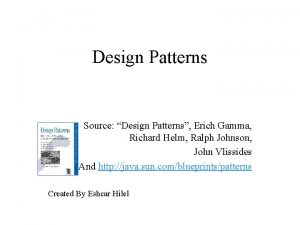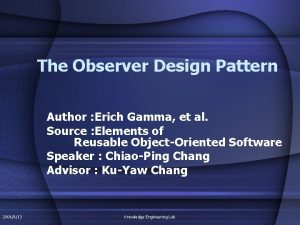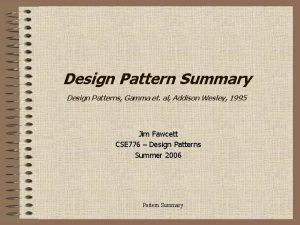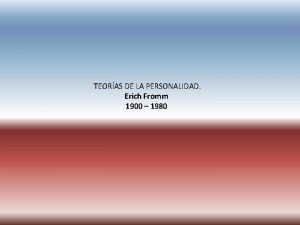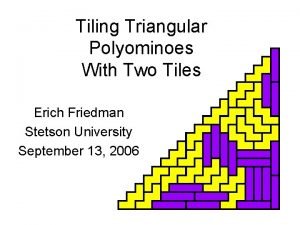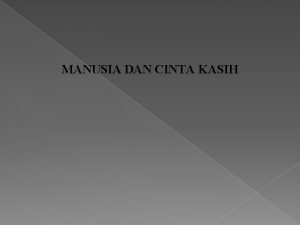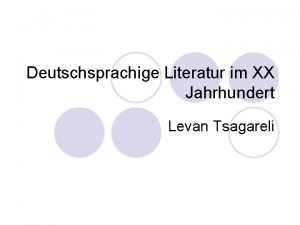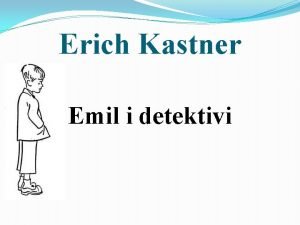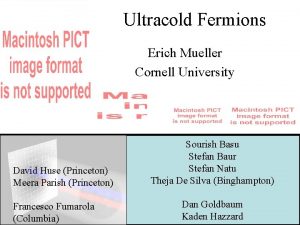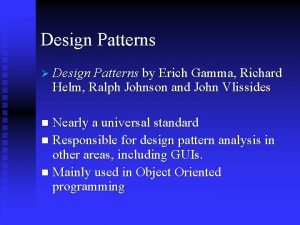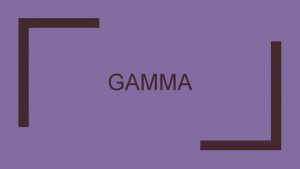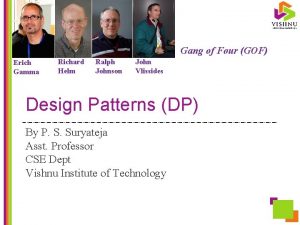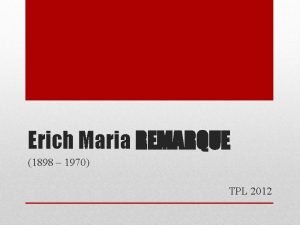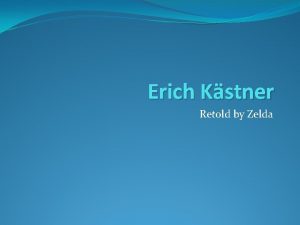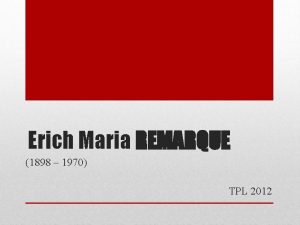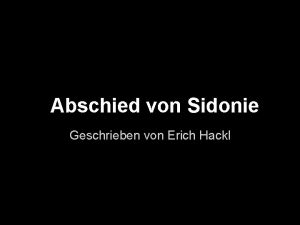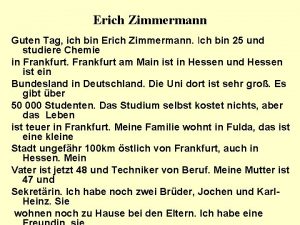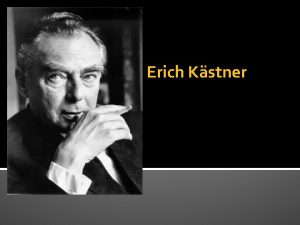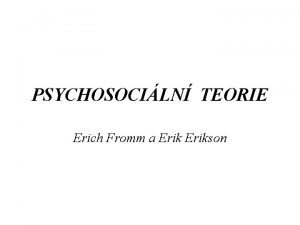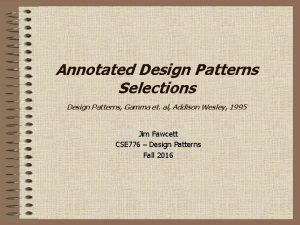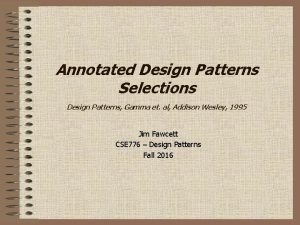Design Patterns Source Design Patterns Erich Gamma Richard




















- Slides: 20

Design Patterns Source: “Design Patterns”, Erich Gamma, Richard Helm, Ralph Johnson, John Vlissides And http: //java. sun. com/blueprints/patterns Created By Eshcar Hilel

Agenda • Design Patterns - Why? • Model-View-Controller Pattern – What Is the Problem? – Solution, Structure, Responsibilities – Class Diagram • MVC variants examples Design Patterns 2

Design Patterns - Why? • Designing OO software is hard • Designing reusable OO software – harder • Experienced OO designers make good design • New designers tend to fall back on non-OO techniques used before • Experienced designers know something – what is it? Design Patterns 3

Design Patterns - Why? • Expert designers know not to solve every problem from first principles Analogy II – Telenovela!! • They reuse solutions • These patterns make OO designs more flexible, elegant, and ultimately reusable Analogy I - Novelists and playwrights: “Tragically Flawed Hero” (Macbeth, Hamlet. . . ) “The Romantic Novel” Design Patterns 4

Two Major Principles of Object-Oriented Design: Dynamic binding, polymorphism. . . • Program to an interface, not an implementation. • Favor object compositions over class inheritance. See more of this in… OOD White-box reuse vs. Black-box reuse Design Patterns 5

Model-View-Controller Pattern • MVC consists of three kinds of objects: – Model – the application object – View – UI (screen presentation) – Controller – defines the way the UI reacts to user inputs Design Patterns 6

MVC – What Is the Problem? • The same enterprise data needs to be accessed when presented in different views: e. g. HTML, JFC/swing, XML • The same enterprise data needs to be updated through different interactions • Supporting multiple types of views and interactions should not impact the components that provide the core functionality of the enterprise application Design Patterns 7

MVC – Solution • Separate core business model functionality from the presentation and control logic that uses this functionality • Allows multiple views to share the same enterprise data model • Makes supporting multiple clients easier to implement, test, and maintain Design Patterns 8

The MVC pattern • The Model is the actual internal representation • The View (or a View) is a way of looking at or displaying the model • The Controller provides for user input and modification • These three components are usually implemented as separate classes 9

MVC – Responsibilities • Model - the model represents enterprise data and the business rules that govern access to and updates of this data • View -the view renders the contents of a model. It accesses enterprise data through the model and specifies how that data should be presented • Controller - the controller translates interactions with the view into actions to be performed by the model Design Patterns 10

MVC Structure Design Patterns 11

The Model • Most programs are supposed to do work, not just be “another pretty face” – but there are some exceptions – useful programs existed long before GUIs • The Model is the part that does the work--it models the actual problem being solved • The Model should be independent of both the Controller and the View – But it provides services (methods) for them to use 12 • Independence gives flexibility, robustness

The Controller • The Controller decides what the model is to do • Often, the user is put in control by means of a GUI – in this case, the GUI and the Controller are often the same • The Controller and the Model can almost always be separated (what to do versus how to do it) • The design of the Controller depends on the Model • The Model should not depend on the Controller

The View • Typically, the user has to be able to see, or view, what the program is doing • The View shows what the Model is doing – The View is a passive observer; it should not affect the model • The Model should be independent of the View, but (but it can provide access methods) • The View should not display what the Controller thinks is happening 14

Combining Controller and View • Sometimes the Controller and View are combined, especially in small programs • Combining the Controller and View is appropriate if they are very interdependent • The Model should still be independent • Never mix Model code with GUI code! 15

Separation of concerns • As always, you want code independence • The Model should not be contaminated with control code or display code • The View should represent the Model as it really is, not some remembered status • The Controller should talk to the Model and View, not manipulate them – The Controller can set variables that the Model and View can read 16

Example Control Flow in MVC • User interacts with the VIEW UI • CONTROLLER handles the user input (often a callback function attached to UI elements) • CONTROLLER updates the MODEL • VIEW uses MODEL to generate new UI • UI waits for user interaction

Three Tier Model Design Patterns 18

Problems • Problems of translation: – Business logic bleeds into the Controller. • Problems of the pattern: – Excessive coupling between the Model and View and the Model and Controller. – Frozen interfaces are hard to manage!

References • Wikipedia • Fox, Christopher. Introduction to Software Engineering Design. Boston: Pearson, 2006. • Burbeck, Steve. Applications Programming in Smalltalk 80(TM): How to use Model-View-Controller (MVC). http: //st-www. cs. uiuc. edu/users/smarch/st-docs/mvc. html • Morse, Scot F. Introducing Application Design and Software Engineering Principles in Introductory CS Courses: Model-View-Controller Java Application Framework.
 Erich gamma
Erich gamma Erich gamma
Erich gamma Design pattern gamma
Design pattern gamma Looking for richard
Looking for richard Personalidad erich fromm
Personalidad erich fromm Paul remark
Paul remark Erich fromm haben oder sein
Erich fromm haben oder sein Erich fried biographie
Erich fried biographie Erich friedman
Erich friedman Erich mueller cornell
Erich mueller cornell Pengertian cinta kasih
Pengertian cinta kasih Erich maria remarque současníci
Erich maria remarque současníci Erich fried 17.-22. mai 1966
Erich fried 17.-22. mai 1966 Llcbench
Llcbench Remarque literarne obdobie
Remarque literarne obdobie Erich vogt
Erich vogt Emil i detektivi ilustracija
Emil i detektivi ilustracija Erich mueller cornell
Erich mueller cornell Erich reber krank
Erich reber krank Hans erich nossack
Hans erich nossack Erich baumgartner
Erich baumgartner
